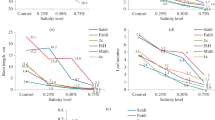Abstract
The salt tolerance potential of variousAegilops species of different genome combinationsviz., Aegilops squarrosa, Ae. cylindrica, Ae. ovata. Ae. triuncialis, Ae. variabilis, Ae. bicornis, Ae. longissima, Ae. umbellulata, andAe. sharonensis was tested to identify the high salt-tolerant genotype(s). Screening was done in cement tanks filled with gravel and Hoagland nutrient solution. Salinity was created by mixing Na2SO4, CaCl2, MgCl2 and NaCl in the ratio of 10∶5∶1∶4 and induced by a stepwise increase in electrical conductivity number of tillers and number of leaves. Inter-and intragenomic variations for cation uptake were also significant. Species with DD and CD genome were found to be highly tolerant. Possible factors responsible for these observations have been discussed.
Similar content being viewed by others
References
Anonymous 1954 Diagnosis and improvement of saline and alkali soils. USDA Handbook No. 60 U.S. Govt. Printing Office, Washington DC, pp 160.
Dewey D R 1984 The Genomic system of classification as a guide to intergeneric hybridization with PerennialTriticeae. In Gene Manipulation in Plant Improvement. Ed. J P Gustafson. pp 209–279. Plenum Press.
Dvorak 1971 Hybrids between diploidAgropyron elongatum andAegilops squarrosa Can. J. Genet. Cytol. 13, 90–94.
Dvorak J 1980 Homology betweenAgropyron elongatum chromosomes andTriticum aestivum chromosomes. Can. J. Genet. Cytol. 22, 237–259.
Dvorak J, Kathleen R and Mendlinger S 1985 Transfer of salt tolerance fromElytrigia pontica to wheat by the addition of an incomplete Elytrigia. Genome. Crop Sci. 25, 306–309.
Farooq S, Aslam Z, Niazi M L K and Shah TM 1987 Salt tolerance potential of wild resources of the tribe triticeaae. I. Screening of perennial genera. Pak. J. Sci. Ind. Res. 341, 506–511.
Feldman M, Sear E R 1981 The wild gene resources of wheat. Sci. Am. 244, 306–309.
Gorham J, Hardy C, Wyn Jones R G, Joppa L R and Law C N 1987 Chromosomal location of a K/Na discrimination character in the D genome of wheat. Theor. Appl. Genet. 74, 584–588.
Hoagland D R and Arnon D I 1950 The water culture method for growing plants without soil. Cal. Agric. Exp. Sta, Univ. California, Berrkeley College Agriculture Circular No. 347.
Kingsbury R W and Epstein E 1984 Selection for salt resistant spring wheat. Crop Sci. 24, 310–315.
Knott D R and Dvorak J 1976 Alien germplasm as a source of resistance to disease. Annu. Rev. Phytopathol. 14, 211–235.
McGuire P E and Dvorak J 1981 High salt tolerance potential in wheat grasses. Crop Sci. 21, 702–705.
Mujeeb-Kazi A, Roldan S, Suh D Y, Sitch L A and Farooq S 1987 Production and cytogenetic analysis of hybrids betweenTriticum aestivum and some caespitoseAgropyron species. Genome 29, 537–553.
Qureshi R H, Salim M, Aslam Z and Sandhu G R 1977 An improved gravel culture technique for salt tolerance studies on plants. Pak. J. Agric. Sci. 14, 11–18.
Rana R S, Joshi Y C, Kedar A and Singh K N 1976 Adaptive characteristics of salt tolerant genotypes: Mineral analysis and growth characteristics. Annual Rep CSSRI, Karnal.
Sear E R 1956 The transfer of leaf rust resistance fromAegilops umbellulata to wheat. Brookhaven Sym. Biol. 9, 1–12.
Shah S H, Gorham J, Forster B P and Wyne Jones R G 1987 Salt tolerance in Triticeae: The contribution of D genome to cation selectivity in hexaploid wheat. J. Exp. Bot. 38, 254–269.
Shannon M C 1978 Testing salt tolerance variability among tall wheat grass lines. Agron. J. 70, 719–722.
Storey R, Gorham D R and Shepherd K W 1985 Modification of the salinity response of wheat by the genome ofElytrigia elongatum. Plant and Soil 83, 327–330.
Warham E J, Mujeeb-Kazi A and Rosas V 1984 Screening ofAegilops species for Karneal bunt (Neovossia indica) resistance and their practical utilization forTriticum improvement. Agron. Abs. p. 94.
Watanabe N 1983 Variations of D genome affecting the morphological characters of common wheat. Jap. J. Br. 33, 296–302.
Author information
Authors and Affiliations
Rights and permissions
About this article
Cite this article
Farooq, S., Niazi, M.L.K., Iqbal, N. et al. Salt tolerance potential of wild resources of the tribe Triticeae. Plant Soil 119, 255–260 (1989). https://doi.org/10.1007/BF02370417
Received:
Revised:
Issue Date:
DOI: https://doi.org/10.1007/BF02370417




